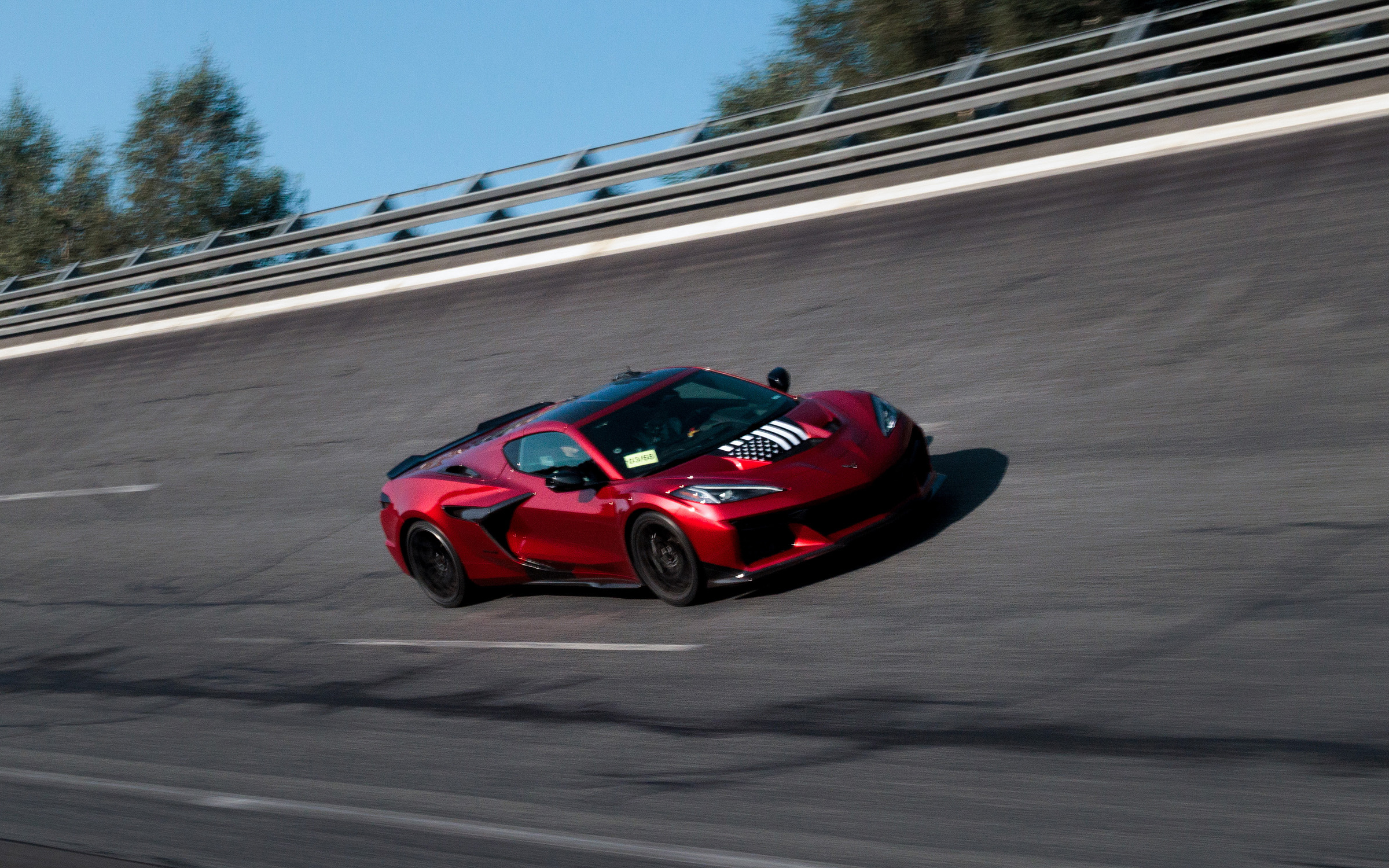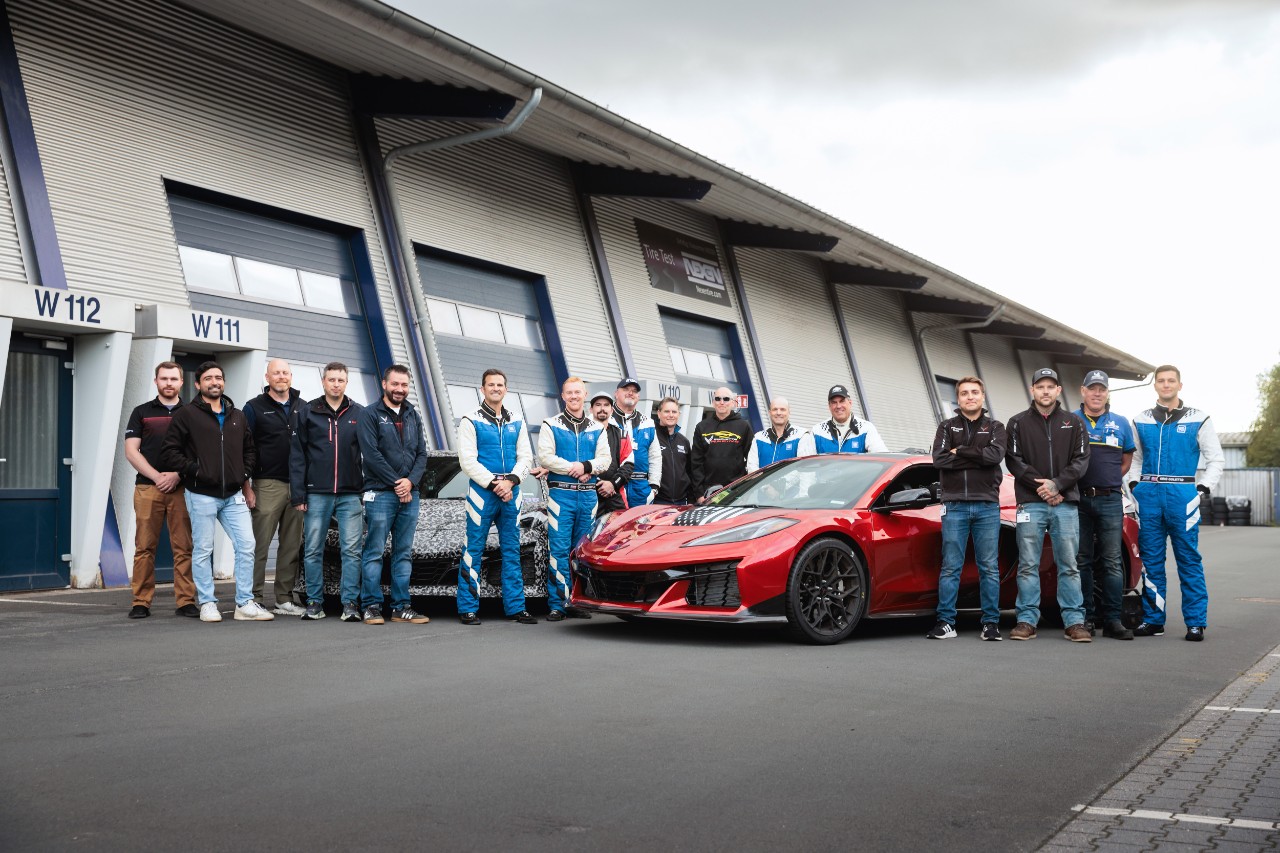The inside story on the Corvette ZR1’s record speed run
2024-10-15
As the 2025 ZR1 rounded the curve, it was already going faster than any factory stock Corvette in history.
“He was doing 222 miles per hour in the banking,” says Chris Barber, Corvette ZR1 lead development engineer. At that velocity, the all-new ZR1 had already beaten the Corvette top-speed record by 10 mph. But the 1,064-horsepower machine had more to give.
Coming off the banked curve and onto the 2.5-mile straightaway on the test track in Papenburg, Germany, the driver put his foot to the floor. Seconds later, the ZR1—with General Motors President Mark Reuss behind the wheel—hit a top speed of 233 mph.
In that moment, the ZR1 became the fastest car ever built by an American auto manufacturer, the fastest current production car priced under $1 million, and the fastest factory-stock Corvette on earth.
“This car actually overachieved,” Barber says.
We actually didn’t think 233 was in the cards.
When development began on the C8-generation Corvette, engineers set a target top speed of 220 mph for the ZR1 on the track. In testing, the car’s 5.5-liter, flat-plane-crank, twin-turbo LT7 V8 blew past the team’s lofty horsepower goals. So they pushed the top-speed objective to 230 mph. “The team had to decide, is this worth the effort,” Barber said.
For Barber and his Corvette colleagues, the answer was immediate. “Everybody unanimously said yes. Let’s go do the best we can do.”
The Corvette engineering team chose ATP Automotive Testing Papenburg, in the northwest corner of Germany, as its test site. ATP’s high-speed oval track is shaped like a paper clip. One lap covers 7.6 miles; in the curves, the pavement is banked nearly 50 degrees, so steep you’d struggle to stand on it. Driving around these bends at 150 mph feels exactly like driving on straight, flat pavement—the tilt of the road counteracts the g-force that would otherwise try to claw you out of your seat.
At speeds over 200 mph, those curves aren’t so gentle. Barber drove the ZR1 at Papenburg himself, reaching over 230 mph on a one-way practice run. (Official top-speed records take the average of two runs in opposite directions to account for wind.)
“Going into the banking was the most intense part,” he says. “That feeling is unlike anything I’ve ever experienced. It just pushes you so hard into the ground. Even NASCAR tracks, they don’t come close to 50-degree banking. Almost nobody gets to experience something like that.”
As for the straightaway blast past 230 mph? “The car feels stable so that it doesn’t present as that big of an event,” Barber said. The ZR1 that set the speed record was 100-percent factory stock, with production-spec engine software, the standard aero package, and stock-fitment Michelin Pilot Sport 4S tires on aluminum wheels. “It just feels like you’re going pretty fast on the highway,” says Barber. “Which is crazy to say, but that’s how good the car was.”
That approachability proved to be an asset for Reuss. The GM president, along with GM senior vice president Ken Morris, had just landed in Germany. The two executives, both seasoned race-car drivers, ran practice laps at 150 mph, getting a feel for the car and the track. A short warm-up was all they needed. “They were both ready to go,” Barber said. “They had confidence, like, let’s do this.”
The next day, Reuss hit 233 mph on two runs in opposite directions, setting a top speed that even the Corvette lead development engineer wasn’t expecting.
“We actually didn’t think 233 was in the cards,” Barber says. “That’s part of the reason everyone was so excited. Not only did we meet the target, we did better. It speaks to the confidence the car provides, how easy it felt for us to do something that sounds just insane.”
Reuss was hardly out of the car before the team gave him the official top speed. “Everyone was clapping, the excitement level was crazy,” Barber says. “We’ve done some cool stuff, but I’ve never seen the group so ecstatic. Having Mark Reuss there as the driver just added to it. We’re proud as the Corvette team, but to have Mark be so involved speaks to the importance of what this means. This is a pretty historic thing.”
At 233 mph, the 2025 Chevrolet Corvette ZR1 is now the fastest car ever built by an American auto manufacturer. Preproduction model shown. Actual production model may vary.
As the 2025 ZR1 rounded the curve, it was already going faster than any factory stock Corvette in history.
“He was doing 222 miles per hour in the banking,” says Chris Barber, Corvette ZR1 lead development engineer. At that velocity, the all-new ZR1 had already beaten the Corvette top-speed record by 10 mph. But the 1,064-horsepower machine had more to give.
Coming off the banked curve and onto the 2.5-mile straightaway on the test track in Papenburg, Germany, the driver put his foot to the floor. Seconds later, the ZR1—with General Motors President Mark Reuss behind the wheel—hit a top speed of 233 mph.
In that moment, the ZR1 became the fastest car ever built by an American auto manufacturer, the fastest current production car priced under $1 million, and the fastest factory-stock Corvette on earth.
“This car actually overachieved,” Barber says.
We actually didn’t think 233 was in the cards.
When development began on the C8-generation Corvette, engineers set a target top speed of 220 mph for the ZR1 on the track. In testing, the car’s 5.5-liter, flat-plane-crank, twin-turbo LT7 V8 blew past the team’s lofty horsepower goals. So they pushed the top-speed objective to 230 mph. “The team had to decide, is this worth the effort,” Barber said.
For Barber and his Corvette colleagues, the answer was immediate. “Everybody unanimously said yes. Let’s go do the best we can do.”
The Corvette engineering team chose ATP Automotive Testing Papenburg, in the northwest corner of Germany, as its test site. ATP’s high-speed oval track is shaped like a paper clip. One lap covers 7.6 miles; in the curves, the pavement is banked nearly 50 degrees, so steep you’d struggle to stand on it. Driving around these bends at 150 mph feels exactly like driving on straight, flat pavement—the tilt of the road counteracts the g-force that would otherwise try to claw you out of your seat.
At speeds over 200 mph, those curves aren’t so gentle. Barber drove the ZR1 at Papenburg himself, reaching over 230 mph on a one-way practice run. (Official top-speed records take the average of two runs in opposite directions to account for wind.)
“Going into the banking was the most intense part,” he says. “That feeling is unlike anything I’ve ever experienced. It just pushes you so hard into the ground. Even NASCAR tracks, they don’t come close to 50-degree banking. Almost nobody gets to experience something like that.”
Members of the Corvette team, including General Motors President Mark Reuss at the track in Papenburg, Germany. Preproduction models shown. Actual production model may vary.
As for the straightaway blast past 230 mph? “The car feels stable so that it doesn’t present as that big of an event,” Barber said. The ZR1 that set the speed record was 100-percent factory stock, with production-spec engine software, the standard aero package, and stock-fitment Michelin Pilot Sport 4S tires on aluminum wheels. “It just feels like you’re going pretty fast on the highway,” says Barber. “Which is crazy to say, but that’s how good the car was.”
That approachability proved to be an asset for Reuss. The GM president, along with GM senior vice president Ken Morris, had just landed in Germany. The two executives, both seasoned race-car drivers, ran practice laps at 150 mph, getting a feel for the car and the track. A short warm-up was all they needed. “They were both ready to go,” Barber said. “They had confidence, like, let’s do this.”
The next day, Reuss hit 233 mph on two runs in opposite directions, setting a top speed that even the Corvette lead development engineer wasn’t expecting.
“We actually didn’t think 233 was in the cards,” Barber says. “That’s part of the reason everyone was so excited. Not only did we meet the target, we did better. It speaks to the confidence the car provides, how easy it felt for us to do something that sounds just insane.”
Reuss was hardly out of the car before the team gave him the official top speed. “Everyone was clapping, the excitement level was crazy,” Barber says. “We’ve done some cool stuff, but I’ve never seen the group so ecstatic. Having Mark Reuss there as the driver just added to it. We’re proud as the Corvette team, but to have Mark be so involved speaks to the importance of what this means. This is a pretty historic thing.”

